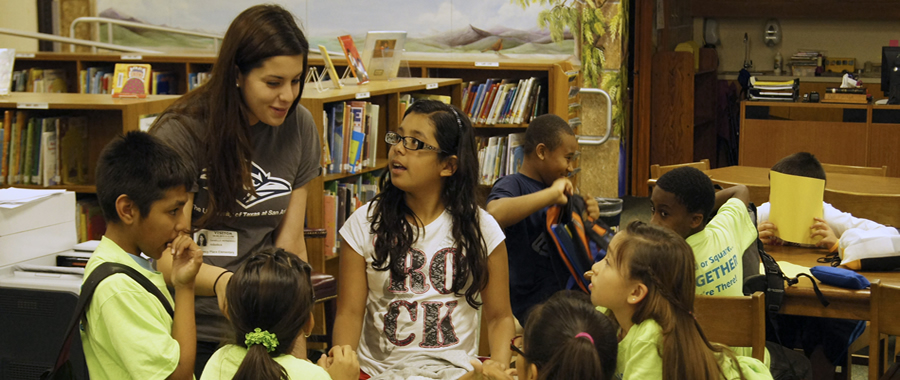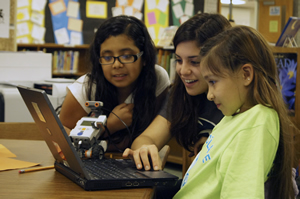


For many students, Mondays signify the end of the weekend and the start of a new school week. For Danielle Hernandez, Mondays meant having the opportunity to give back to the community and apply her class work in the real world by working one-on-one with local elementary school students.
Hernandez was one of 30 students who participated in a service learning project through the Academy for Teacher Excellence (ATE), one of the centers in the College of Education and Human Development (COEHD) at The University of Texas at San Antonio (UTSA). Service learning, or the application of lessons learned in the classroom to real-world situations, is completed through semester or yearlong service projects. Hernandez’s project was mentoring Robotics Club members at Regency Place Elementary School’s, a dual-language, Title I elementary school in the Northeast Independent School District.

Once a week, Hernandez and the other UTSA student mentors involved in one of ATE’s service learning projects would travel to one of the seven participating elementary or middle schools in Southside ISD, South San ISD, Edgewood ISD, Northside ISD, or Northeast ISD, which serve a high number of Latinos and other under-served and under-represented student populations. There, they would work with students to develop 21st century skills through robotics in these informal learning clubs.
“Our job as leaders or mentors was to try to encourage them to reach higher and not give up,” said Hernandez, a COEHD interdisciplinary studies major with a concentration in math and science for fourth through eighth grade. “You could just see them light up and they were all excited about what they were going to do that day.”
The UTSA undergraduate student mentors were placed in groups of four to five and sent to the partner schools to assist the clubs’ sponsors and help the students achieve weekly goals, from building the robots to programming the robots to move a certain way.
“Sometimes we were trying to program it [the robot] to go straight, go left and turn around and all of the kids were really excited,” said Hernandez. “They wanted to be a part of something bigger. They knew they were going to compete and I knew that I was going to help them go through all of those processes and guide them to an end goal.”
According to ATE Principal Investigator Belinda Bustos Flores, service learning does more than give back to the community. The robotics clubs increase participants’ access to informal learning opportunities and enrich experiences that promote creativity and inquiry.
“[These schools] don’t necessarily have the funds for the resources that we can provide them under the grant,” said Shannon Sczech, ATE educational specialist. “Service learning has also been eye-opening for some of these UTSA student mentors to see how much some of these younger kids don’t have.”
Service learning is offered university- wide through the Inclusion and Community Engagement Center, but ATE’s Service Learning is unique. The service learning opportunities offered through ATE are open to all majors, allowing students from a multitude of disciplines to work together on a particular project, emphasizing cross-disciplinary collaboration. For Hernandez, that collaboration allowed her to work with engineering majors.
“We are willing to collaborate with anyone, students and professors,” said Sczech. “We are always open to collaborative efforts at the university.”
One of the goals for this upcoming semester is to increase both student and faculty participation, a goal Sczech hopes they will meet. Currently, ATE’s service learning opportunities are not tied to certain college courses, but eventually, Sczech would like to collaborate with professors from across the university so that the students can get course credit for their work.
“Right now, we hope that we can keep it going,” said Sczech. “We want undergraduates and, even more so, faculty members coming to us to see what we are about and what we offer to help them with whatever they need.”
Aside from the robotics clubs, which was the most popular service learning project during the 2012- 2013 school year, ATE also offers service learning opportunities in face-to-face tutoring, virtual tutoring, facilitating professional development events, student internships, assisting the ATE office with day-to-day tasks, other informal learning clubs and the opportunity to act as an alumni mentor. Students who participate in service learning must be willing to commit to at least 25 hours of community service a semester. Informal learning club mentors also receive technology to enhance their academic studies, which mentors can keep upon completion of their two-semester commitment.
“I’d really like to see some of them [service learning opportunities] really get off the ground, like online tutoring,” said Sczech. “We want to continue building and developing the informal learning club mentors because we will have pre-Columbian math clubs getting started and we’ll need undergraduates’ assistance with those.”
For some UTSA students, working with the elementary school children has given them the confidence they needed to continue the pursuit of their degree.
“Robotics has just opened up my eyes to many opportunities for teaching and [seeing] just what that looks like and getting some experience,” said Hernandez. “I chose this degree because I met a middle school teacher and he had told me all these great stories about how he loved his job. He was telling me all about the kids and the reward of being able to guide and mentor students into learning. I am just excited to be a part of that, especially in middle school. I really want to be a light into the middle school because I know a lot of kids are struggling.”
Other UTSA students received a sense of gratification when their elementary students participated in competitions and won. Matthey Middle School in Southside ISD was one of the seven schools that participated in ATE’s service learning outreach. This past spring, their Robotics Club, lead by faculty advisor and seventh and eighth grade science teacher Ron Wells, competed against 16 other middle school teams with their underwater remotely operated vehicle in the NASA ROME Challenge. They tied for first place.
“I have the highest regard for the UTSA student mentors and I hope they continue with the program,” said Wells. “They all had this spark in their eye about wanting to work with children and that is the reason why we are there.”